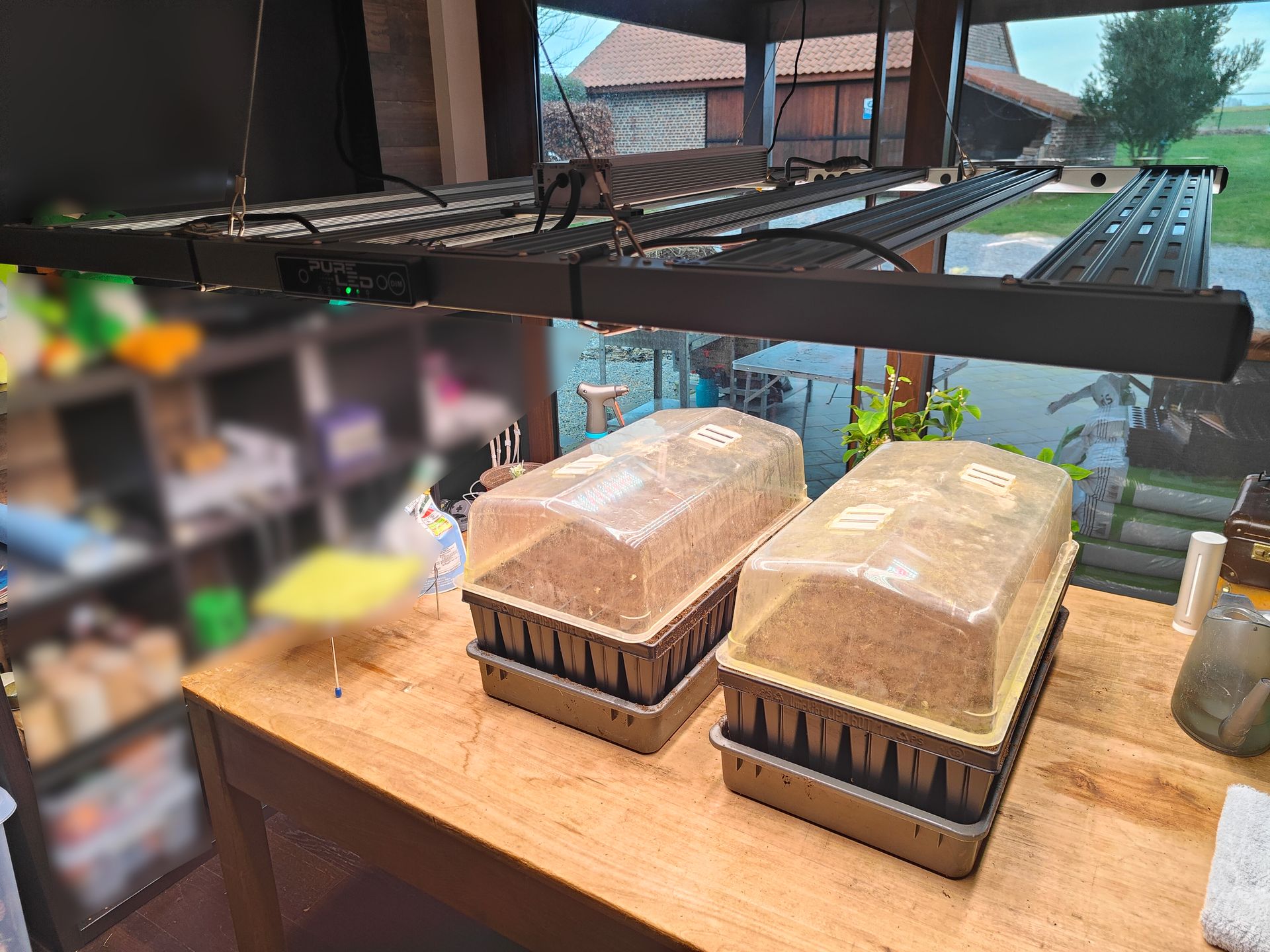In this blog, we will see how to create a nursery in a room of the house to have beautiful plants as early as possible in the year.
Let's go!
The big bad frost!
In our regions, in Belgium as far as we are concerned, but this also applies to all areas located north of the Loire, we cannot sow our vegetables too early in the year. Indeed, until the famous Ice Saints - on May 13, there is always a risk of frost that can destroy frost-sensitive plants.
We know that frost is dangerous for many plants, but what are the real effects of frost? I hope you're in a good mood because we're now going to talk about death and destruction.😏
- A plant is primarily composed of water. When it freezes, it forms crystals that puncture the internal cell walls and cause ruptures in the external tissues as they expand.
- The water turned into ice is no longer available for plants, which become dehydrated.
- The frost blocks the plant's conductive vessels and prevents the circulation of water and nutrients. Basically, the frost blocks photosynthesis.
- As a result of frost action, the damaged tissues become necrotic.
- Furthermore, damaged plants are weakened and more vulnerable to other forms of stress to come, such as diseases and drought.
- Finally, the damaged buds and roots hinder the plant's development, which will lead to stunted growth.
In short, freezing is not cool! 🥶
In short, freezing is not cool! You must be particularly vigilant for young shoots (fragile, tender and waterlogged) as well as flowering plants.
All this is very beautiful but if you only start growing your plants in mid-May, you will have to wait a good 3 months before getting a good little Mozarella tomato.
One relatively inexpensive solution is to start your plants in an indoor nursery. Let's see how to do it.
Let's see how to do it.
The stages of growth of a plant
First of all, it is important to understand the growth stages of a plant and its specific needs at each stage. For the sake of simplicity, I will remain very general here, even though the needs can vary from one type of plant to another. A more detailed description of the needs based on the plants could be the subject of another blog. Nevertheless, the values mentioned earlier are valid for the vast majority of vegetables and can therefore serve as a working basis.
Germination
It's magical!
All the genetic heritage of a vegetable is found in a very small seed and it can wait for years, if stored in good conditions, before waking up. It is said to be dormant. To bring the seed out of its form and make it germinate, you must provide it with heat and humidity. Light is still optional at this stage.
Parameter | Value |
Temperature | 18°-22° |
Light | N.A. |
Duration of exposure | N.A. |
Humidity | 80%-90% |
The development of seedlings
At this stage, primary roots develop to anchor the plant and absorb nutrients. The first “false” leaves, the cotyledons appear. The plant needs a moderate amount of light, a mild temperature and moist, well-drained soil.
Parameter | Value |
Temperature | 18°-22° |
Light | 10.000 lux |
Duration of exposure | 12-16 hours |
Humidity | 60-70% |
Vegetative growth
The machine, or should I say the factory, is now launched. True leaves appear, roots spread, and stems lengthen. The plant needs plenty of light for a long period of time to initiate photosynthesis. It also feeds on essential nutrients, the famous NPK - see the Blog The Nitrogen Hunger, present in the substrate
Parameter | Value |
Temperature | 18°-22° |
Light | 20.000 - 35.000 lux |
Duration of exposure | 14-18 hours |
Humidity | 50%-70% |
Now let's review these parameters in more detail to build a healthy nursery.
The temperature
As mentioned earlier, I take average values which explains that the temperature ranges are identical at each stage. Temperatures are a little higher for warm season vegetables - tomatoes, peppers... - and a little lower for cold season vegetables - cabbage, spinach... But hey, if you maintain a temperature of 18- 22° everything should be fine 😉
Be careful of temperatures that are too low, which will slow down or even inhibit the development process, while temperatures that are too high risk causing thermal stress with the consequence of unbalanced growth of the plant and wilting of the plant.
In all cases, try to maintain a maximum temperature difference of 5° between day and night.
If you set up the nursery in a room in your home, the temperature shouldn't be difficult to control.
The humidity
The humidity level is particularly critical during the germination phase to break the seed's dormancy. Therefore, it is important to properly moisten the substrate during sowing. Then, regularly mist water on the seedlings to keep them evenly moist without being waterlogged. Be careful not to provide too much water or to apply it too "violently" - for example, with a watering can - so as not to disturb the seed. For my part, I use a misting spray bottle to moisten the substrate. You can also add a layer of water in the growing tray so that it rises into the substrate by capillarity. Finally, place a transparent lid or a dome over the growing tray to maintain the humidity level (and it will also help to retain heat)..
During the following phases, the humidity level should be moderate. It is important to avoid water stagnation on the substrate and to ensure good ventilation. At this stage, excess humidity may promote the development of diseases such as damping-off. In general, moisten the substrate instead of the leaves directly to reduce the risk of diseases and especially the cryptogamic diseases.
The light
As much as adjusting the temperature or humidity is still quite simple, adjusting the light is more complicated.
Indeed, you may have read earlier that plants require a certain light intensity as well as a fairly long duration of exposure. In our regions, we do not meet either of these criteria during the first months of the year. Even if you place your plants in a well-lit room and on the windowsill, you will not achieve the desired duration of exposure..
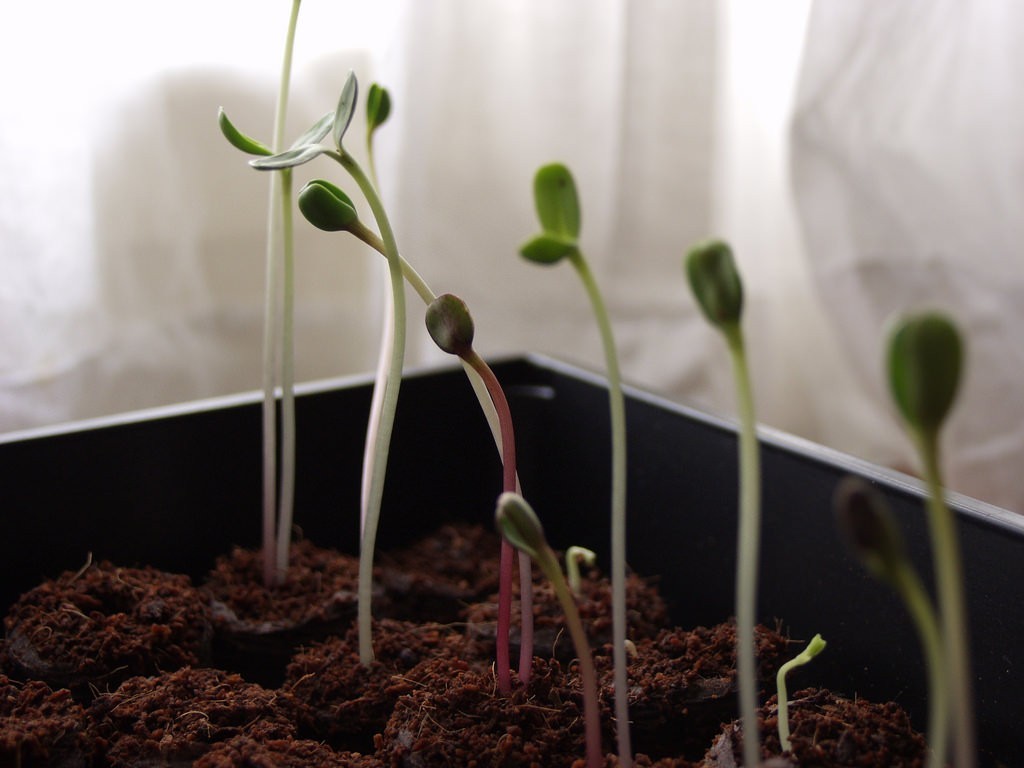 In addition, and I discovered this to my cost, double or triple glazing filters part of the UV and infrared rays necessary for photosynthesis. So you think that your seedlings are exposed to sunlight when not! 😯 The immediate consequence is that they “spin” during the vegetative growth period. You will notice this in plants that grow very quickly and very tall. Basically this may seem like good news but in fact the plant seeks out the light and therefore grows like a vine towards what it “thinks” is a source of light instead of consolidating its base. In the end you have a thin plan which will remain fragile and may not recover when you put it in the ground. Fortunately, if detected in time, it is possible to recover a plant that is “spinning”. This is a good topic for another Blog 😏
In addition, and I discovered this to my cost, double or triple glazing filters part of the UV and infrared rays necessary for photosynthesis. So you think that your seedlings are exposed to sunlight when not! 😯 The immediate consequence is that they “spin” during the vegetative growth period. You will notice this in plants that grow very quickly and very tall. Basically this may seem like good news but in fact the plant seeks out the light and therefore grows like a vine towards what it “thinks” is a source of light instead of consolidating its base. In the end you have a thin plan which will remain fragile and may not recover when you put it in the ground. Fortunately, if detected in time, it is possible to recover a plant that is “spinning”. This is a good topic for another Blog 😏
The ideal is to have a supply of artificial light either via horticultural lamps or T5 or T8 fluorescent tubes (Philips, Osram Or Sylvania). For my part, I opted for a PureLED horticultural lamp... PureLED Pro 680W bought at GrowLED. When purchasing this type of lamp, it is important to consider the consumption, the heat emitted, the PPF - light intensity - and the PPFD - the distribution of light over the surface. More explanations in another blog. !!!
Little anecdote: by buying this type of lamp, you will quickly understand that their clientele also grows plants, but not only in the field of "traditional" horticulture. 🤯- Watch the lamp assembly video in the Videos section
CO2 level and aeration
A natural CO2 level, around 400ppm, is generally sufficient for most plants.
A priori, in a normal environment, the CO2 level is not a problem. Just remember to ventilate the room regularly, while maintaining a good temperature and a good humidity level, and if you are lacking CO2, add more plants or stay in the room - you will exhale CO2. 😏
The seeds
It's good to have the right parameters for your nursery, but you still need to have the raw materials.!
As explained in the Blog Market gardening, a question of planning we ordered all our seeds from Agrosemens.
And yes, they arrived. Watch the Seed Unboxing video in the Videos section
The growing trays
For the culture plates, I opted for two tray formats Quickpot bought at Ferauche & Gillet.
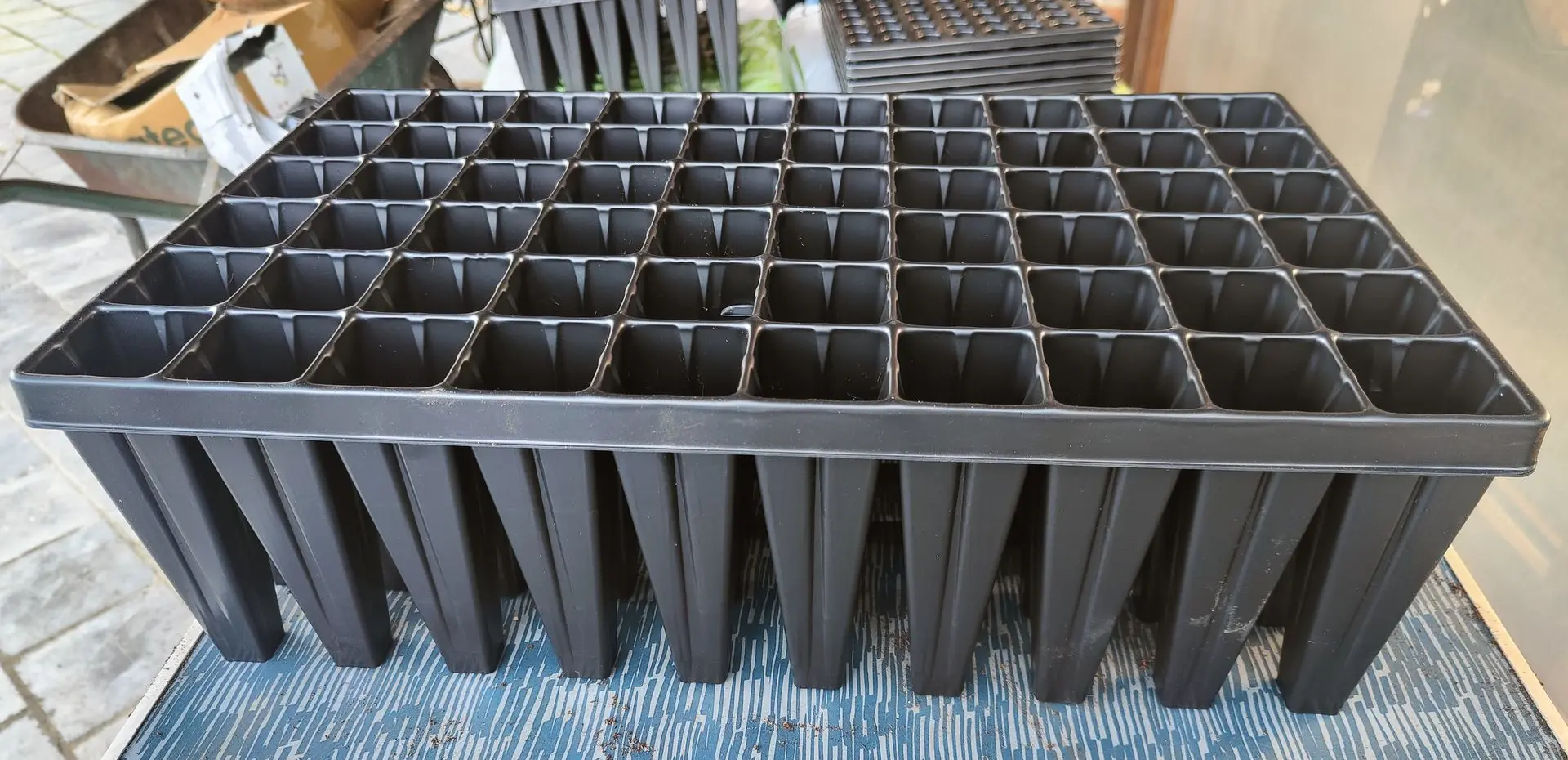 A tray of 60 rectangular cells measuring 45cm on each side and 70cm deep. They are very tall and require a fairly large quantity of potting soil. I use them for plants with a fairly developed root system and which will stay in the nursery for a long time. For example, I plant the first cabbages in mid-January and I plant them in the ground at the beginning of March. They therefore remain in the pot for 7 weeks. The same goes for tomatoes and peppers. My bet, by taking larger containers, is to not have to repot my plants in a larger pot before sowing. In this way, I save time and I less traumatize the roots of the plant by successive manipulations.
A tray of 60 rectangular cells measuring 45cm on each side and 70cm deep. They are very tall and require a fairly large quantity of potting soil. I use them for plants with a fairly developed root system and which will stay in the nursery for a long time. For example, I plant the first cabbages in mid-January and I plant them in the ground at the beginning of March. They therefore remain in the pot for 7 weeks. The same goes for tomatoes and peppers. My bet, by taking larger containers, is to not have to repot my plants in a larger pot before sowing. In this way, I save time and I less traumatize the roots of the plant by successive manipulations.
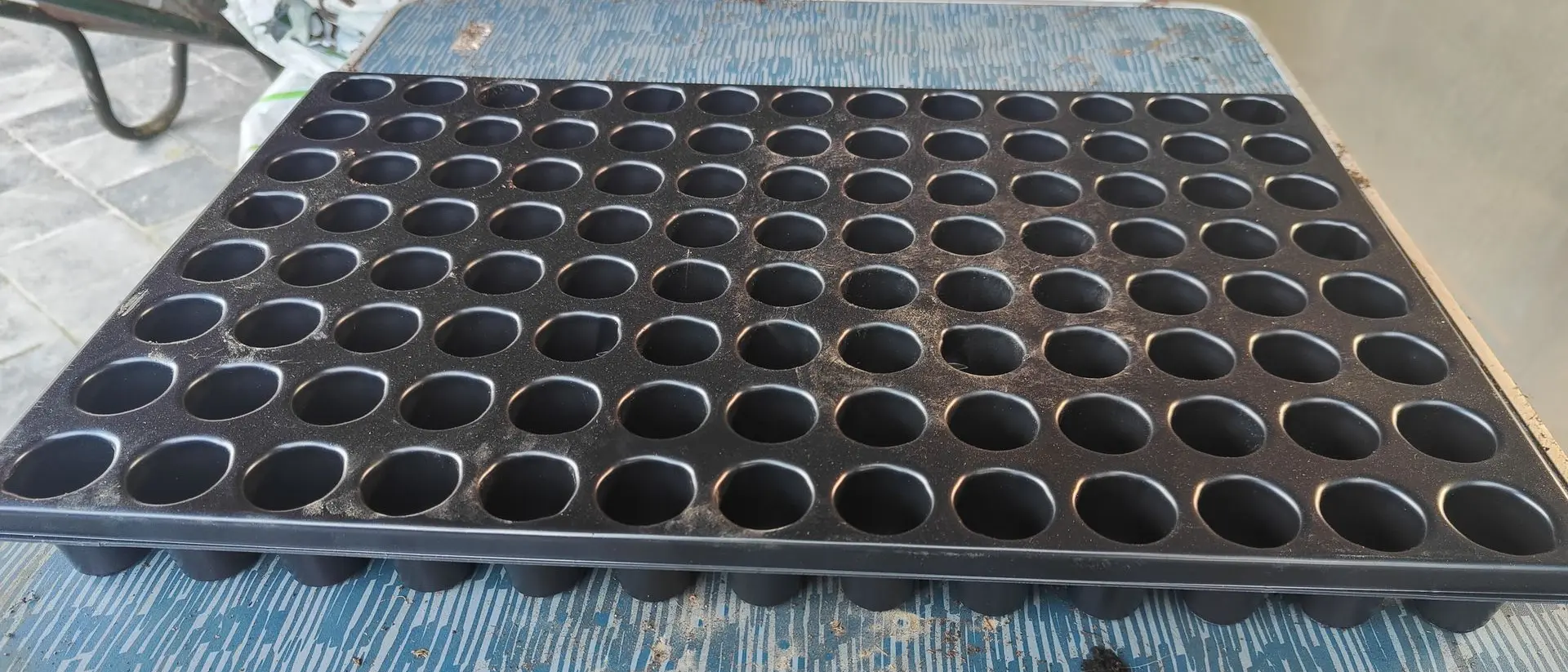 A tray of 104 round cells measuring 31cm in diameter and 45cm in depth for plants that stay in the nursery for a shorter time and have less developed root systems, such as lettuces for example.
A tray of 104 round cells measuring 31cm in diameter and 45cm in depth for plants that stay in the nursery for a shorter time and have less developed root systems, such as lettuces for example.
Please note, these plates do not have a bottom to allow water to drain. So plan a tray so that residual water doesn’t flow everywhere 🤯
I could have also made clumps using a clump press or done some sowing in trays, but I opted for one and only one method to simplify my task..
The potting soil
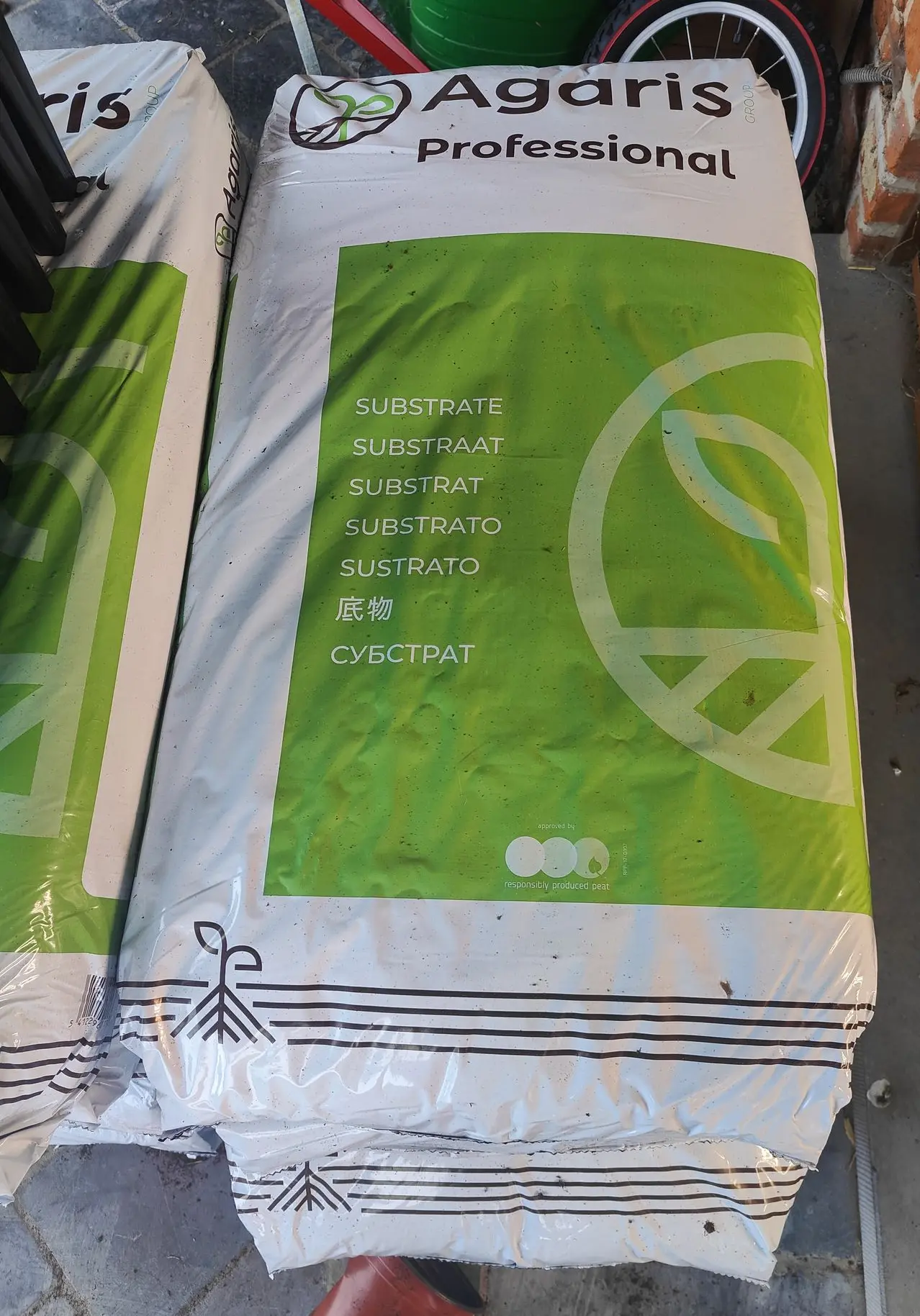
Finally, the choice of substrate is important. Sowing is done in potting soil whose essential component is peat. It plays a vital role in its water retention capacity (up to 20 times its weight in water) and therefore in maintaining constant humidity for the plants. In addition, peat promotes microbial life, improves air retention for better oxygenation of plants and its low pH limits the development of certain fungal diseases.
The major drawback of peat is that it exists in limited quantities in nature, and therefore there is a certain environmental impact in using it. There are increasingly more alternatives to this product, such as coconut fiber or compost..
The second important element in potting soil is perlite which improves its drainage while retaining sufficient water. These are the little white “marbles” in the soil.
Good ! For the potting soil, I took the potting soil PRO BIO - Agaris (Semis) at Ferauche et Gillet. I'm not at all sure I made the right choice. In fact, it is made of peat and does not contain perlite!!!
I just made two 60 cell seedlings - cauliflower and red cabbage. Verdict in a week. Wait and See 🤞
Conclusion
In summary, to create your nursery indoors, you ideally need...
- ...a dedicated room in your house (beware of cats scratching in the dirt 😉)
- ...heating.
- ...a water spray/mini-sprayer.
- ...a horticultural lamp (or other reliable source of light)
- ...culture plates
- ...potting soil
- ...time and love🪴
And you must also take into account the following parameters at each stage of your plants' growth.
Germination | Seedling development | Vegetative growth | |
Temperature | 18°-22° | 18°-22° | 18°-22° |
Light | N.A. | 10.000 lux | 20.000-35.000 lux |
Duration of exposure | N.A. | 12-16 hours | 14-18 hours |
Humidity | 80%-90% | 60-70% | 50%-70% |
Here is the final result with the first two seed trays. As you can see, I keep the lid on during the germination phase to retain moisture..
In a week, the first shoots should be there 🤞
